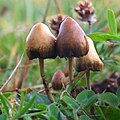Psilocybin mushroom
Psilocybin mushrooms, also known as magic mushrooms, are a polyphyletic group of fungi that contain psilocybin and psilocin. These substances are psychoactive, and have been used in various cultural, religious, and medicinal contexts throughout history.
History[edit]
The use of psilocybin mushrooms dates back to prehistoric times. They have been depicted in rock paintings and other forms of ancient art, particularly in Central and South America. In the modern era, they gained prominence in the 1950s after R. Gordon Wasson, a vice president of J.P. Morgan & Co., published an article about his experiences with these mushrooms in Life magazine.
Biology[edit]
Psilocybin mushrooms belong to the genus Psilocybe. There are over 200 species of Psilocybe worldwide, all of which contain psilocybin and psilocin. These compounds are found in the highest concentrations in the fruiting bodies, or mushrooms, but can also be found in other parts of the fungus.
Effects[edit]
The effects of psilocybin mushrooms are highly variable and depend on factors such as the species of mushroom, the dose, the individual's body chemistry, and the setting in which they are consumed. Effects can include euphoria, altered thinking processes, closed and open eye visuals, synesthesia, an altered sense of time, and spiritual experiences. Negative effects can include nausea, vomiting, and panic attacks.
Legal status[edit]
The legal status of psilocybin mushrooms varies widely around the world. In some countries, such as the Netherlands, they are legal to buy and consume. In others, such as the United States, they are classified as a Schedule I controlled substance and are illegal to manufacture, buy, possess, or distribute.
See also[edit]
This article is a Psychoactive drug-related stub. You can help WikiMD by expanding it!
-
Psilocybin mushroom
-
Psilocybin mushroom
-
Psilocybin mushroom
-
Psilocybin mushroom
-
Psilocybin mushroom
-
Psilocybin mushroom
-
Psilocybin mushroom
-
Psilocybin mushroom
-
Psilocybin mushroom
-
Psilocybin mushroom
-
Psilocybin mushroom
Ad. Transform your life with W8MD's Budget GLP-1 injections from $49.99


W8MD offers a medical weight loss program to lose weight in Philadelphia. Our physician-supervised medical weight loss provides:
- Weight loss injections in NYC (generic and brand names):
- Zepbound / Mounjaro, Wegovy / Ozempic, Saxenda
- Most insurances accepted or discounted self-pay rates. We will obtain insurance prior authorizations if needed.
- Generic GLP1 weight loss injections from $49.99 for the starting dose of Semaglutide and $65.00 for Tirzepatide.
- Also offer prescription weight loss medications including Phentermine, Qsymia, Diethylpropion, Contrave etc.
NYC weight loss doctor appointmentsNYC weight loss doctor appointments
Start your NYC weight loss journey today at our NYC medical weight loss and Philadelphia medical weight loss clinics.
- Call 718-946-5500 to lose weight in NYC or for medical weight loss in Philadelphia 215-676-2334.
- Tags:NYC medical weight loss, Philadelphia lose weight Zepbound NYC, Budget GLP1 weight loss injections, Wegovy Philadelphia, Wegovy NYC, Philadelphia medical weight loss, Brookly weight loss and Wegovy NYC
|
WikiMD's Wellness Encyclopedia |
| Let Food Be Thy Medicine Medicine Thy Food - Hippocrates |
Medical Disclaimer: WikiMD is not a substitute for professional medical advice. The information on WikiMD is provided as an information resource only, may be incorrect, outdated or misleading, and is not to be used or relied on for any diagnostic or treatment purposes. Please consult your health care provider before making any healthcare decisions or for guidance about a specific medical condition. WikiMD expressly disclaims responsibility, and shall have no liability, for any damages, loss, injury, or liability whatsoever suffered as a result of your reliance on the information contained in this site. By visiting this site you agree to the foregoing terms and conditions, which may from time to time be changed or supplemented by WikiMD. If you do not agree to the foregoing terms and conditions, you should not enter or use this site. See full disclaimer.
Credits:Most images are courtesy of Wikimedia commons, and templates, categories Wikipedia, licensed under CC BY SA or similar.
Translate this page: - East Asian
中文,
日本,
한국어,
South Asian
हिन्दी,
தமிழ்,
తెలుగు,
Urdu,
ಕನ್ನಡ,
Southeast Asian
Indonesian,
Vietnamese,
Thai,
မြန်မာဘာသာ,
বাংলা
European
español,
Deutsch,
français,
Greek,
português do Brasil,
polski,
română,
русский,
Nederlands,
norsk,
svenska,
suomi,
Italian
Middle Eastern & African
عربى,
Turkish,
Persian,
Hebrew,
Afrikaans,
isiZulu,
Kiswahili,
Other
Bulgarian,
Hungarian,
Czech,
Swedish,
മലയാളം,
मराठी,
ਪੰਜਾਬੀ,
ગુજરાતી,
Portuguese,
Ukrainian









